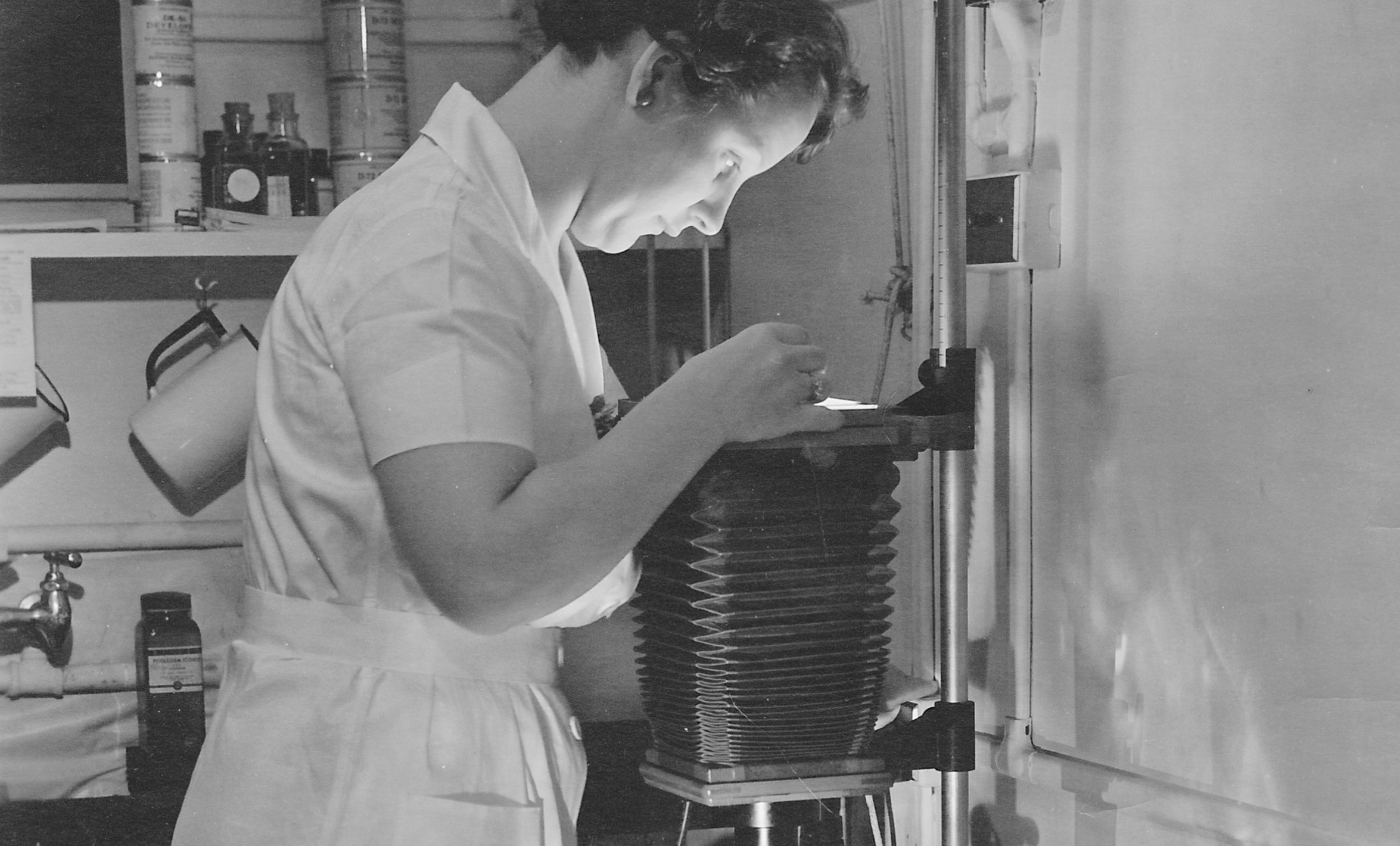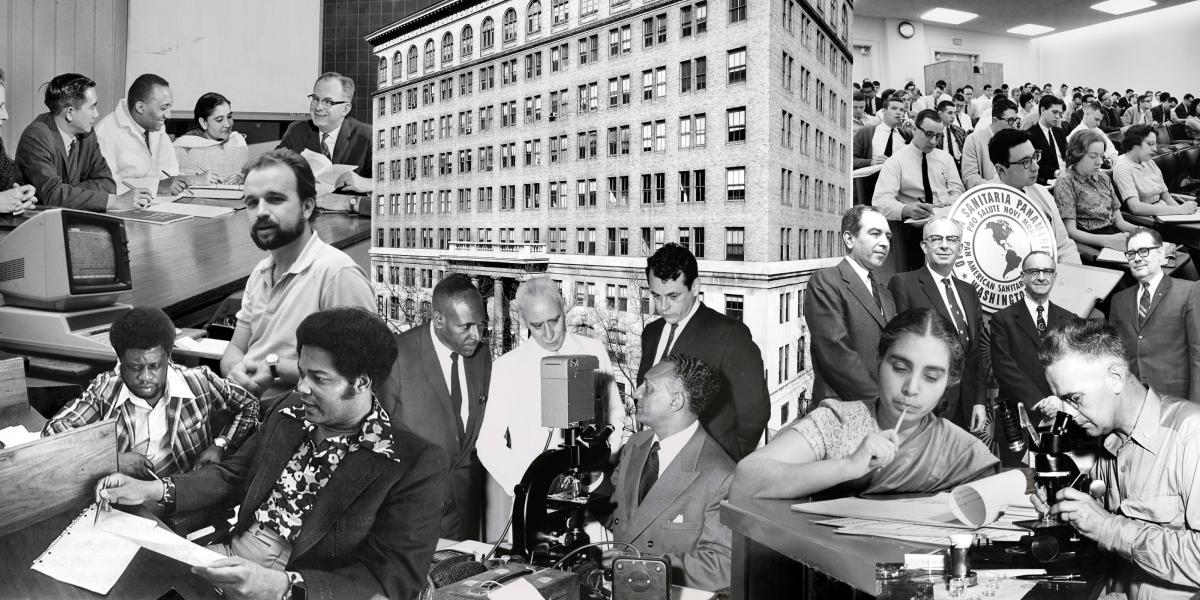The Art of the Pivot
Pandemics. Wars. Existential financial threats. The Bloomberg School has long used its hard-won experience to anticipate and shape the future.
On January 11, 1983, Johns Hopkins President Steven Muller strode across the stage of the Wolfe Street Building’s East Wing Auditorium, sat on a stool, and lit a cigarette. He gave the gathered faculty a frank update on the University’s steep budget deficit—and the School’s record $1.2 million shortfall ($3.8 million in today’s dollars). Muller declared that each University division must secure its own support, without help from the central administration. It would become known as the “every tub on its own bottom” speech.
The faculty knew he was serious—four years before, he had shuttered the financially struggling School of Health Services, where many of them had taught. The 1983 deficit would hit $2.6 million ($8.3 million today), the worst in the School’s history.
The budget shortfall represented the School’s third prolonged funding crisis. Each served as a crucible for its long-term strategic vision and its creative—sometimes risky—quest for new opportunities. Faced with existential threats, School leaders and faculty found ways for the School to do more than survive; they built out a better future for the institution and the field of public health.

Surviving Depression and War
The 1929 stock market crash shrank the School’s primary income source: interest from the Rockefeller Foundation endowment. For the next five years, the Great Depression forced 10% annual budget reductions and layoffs across departments. In 1931, even the dean’s salary was reduced, and scholarships were suspended. Without them, enrollment plunged from 120 students in 1930 to 68 in 1934. Dean Allen Freeman warned University trustees in 1935 that further cuts would cause “serious and permanent damage to the work of the School.”
Just in time, the 1935 Social Security Act created a federal lifeline for public health research and training, which nearly doubled MPH enrollment from 44 to 80 in just three years. In 1942, the School benefited from the World War II spending surge and a transformative poliovirus grant.
Military contracts flooded in, allowing the School to train health officers, battle parasitic diseases that threatened troops in the South Pacific, organize STI treatment facilities to keep soldiers “fit to fight,” and develop antimalarial drugs (which were tested on ducklings housed on the sixth floor).
Banking on Polio Research
In 1942, a $300,000 grant from the National Foundation for Infantile Paralysis (NFIP) to the Department of Epidemiology established the School’s first dedicated research center. Over the next 17 years, the School received $2 million ($28.5 million today) from NFIP, producing essential discoveries such as identifying the three virus types that a vaccine would have to target.
Yet outside the polio-focused departments of Epidemiology and Microbiology, salaries were so poor through the 1950s that many faculty moonlighted for health departments. Microbiology chair Thomas Turner complained that members of his department earned “considerably less than many county health officers or laboratory division chiefs in this country,” and the School’s search committees struggled to recruit department chairs.
By the late 1950s, the last NFIP grants ran out as polio immunization took hold nationwide, and the Rockefeller Foundation stopped supporting U.S. schools of public health in favor of overseas projects. The advent of penicillin, vaccines, and rising living standards drove sharp declines in syphilis, polio, malaria, and tuberculosis. These once-feared diseases nearly vanished from the School’s laboratories and budget. By 1959, Johns Hopkins President Milton Eisenhower called the School “our most critical financial problem.” The board of trustees discussed devolving Public Health into a School of Medicine department.

Catching the Federal Grant Train
But in the 1960s, schools of public health thrived with new support from a raft of Great Society federal health and foreign aid programs, including USAID (1961), Medicare (1965), the Comprehensive Health Planning Act (1966), and the EPA (1970). Seeing the opportunities ahead for reinventing public health with social and behavioral sciences, population dynamics, and other budding disciplines, Deans Ernest Stebbins, MD, MPH ’32, and John Hume, MD, DrPH ’51, reorganized the Department of Public Health Administration as an incubator for new initiatives. This strategy was so successful that it spawned eight new departments from 1962 to 1970, including International Health and Mental Hygiene. The new departments attracted substantial NIH research grants for noncommunicable diseases, developmental disabilities, and other issues. Hume also foresaw the need to create centers and institutes that could quickly address emerging problems and land new funding. The School had six centers when Hume stepped down in 1977; today, it has more than 80.
Most importantly, the 1961 Hill-Rhodes Act funded federal traineeships for almost 60% of all public health students over the next two decades. From 1957 to 1970, the School’s enrollment quadrupled from 92 to 386 and its budget increased 392%.
But social unrest, urban riots, and the Vietnam War undermined political support for President Lyndon Johnson’s domestic policies. In the School’s 1967–1968 annual report, Hume pointed to the “abrupt shift of priorities in the Federal Government and the rude awakening of the Health professions to the fact that the ‘honeymoon is over.’” His tenure from 1967 to 1977 was marred by stagflation and “the perennial fluctuation in federal policy,” which created “a sense of insecurity among the faculty which becomes most wearing.”
Adding to the challenges: The new department chairs tended to be charismatic visionaries who loved starting bold new programs but did not always work together. A faculty member remembered that one chair “had his own world, he might as well have had his own school.”
Despite careful long-term planning and accurately predicting the direction of public health, Stebbins and Hume underestimated the turbulence that big grants and big egos would generate. Federal grants, originally a means to the ends of innovation and financial stability, became an end in themselves. While government funds helped the bottom line, they also stoked divisions among departments and individual faculty over prestige and resources.
From 1970 to 1984, 11 departments were consolidated into five. But even this did not cure the hangover from a hiring and tenure-granting spree that left the faculty top-heavy with full professors. In the wake of a severe recession and a White House eager to slash health and social welfare spending, School leaders responded in the 1980s as they had in the 1930s and 1950s: They left vacant positions unfilled, postponed promotions and tenure, and neglected basic requirements for space and infrastructure.
Yet every decade, the School and its budget steadily grew: In constant 1980 dollars, the budget tripled from $1.2 million in 1940 to $3.7 million in 1950; doubled to $7.6 million in 1960; and tripled to $24.7 million in 1970. While things slowed in the 1970s, the 1980 budget doubled to $56.2 million by 1990—but only with heavy deficits, borrowing, and tapping endowment funds.

Creating New Directions
Since 1983—a low point for both morale and budget deficits—School leaders have perfected two effective defenses to safely navigate dangerous waters: anticipating public health’s future directions with uncanny accuracy and becoming judo masters of diverting the momentum of crisis into productive directions.
When D.A. Henderson, MD, MPH ’60, became dean in 1977, few public health leaders were betting that infectious disease would soon be a national priority. Henderson, who had led the successful WHO global smallpox eradication program, invested heavily in infectious disease research. These efforts paid off almost immediately. In 1983, just two years after the CDC reported the first AIDS cases, epidemiologist Frank Polk launched one of the nation’s first academic AIDS research programs at the School, which joined the NIAID-funded Multicenter AIDS Cohort Study (MACS) in 1984. Not only did MACS generate groundbreaking insights into the disease and the populations at greatest risk, it established the School as an AIDS research powerhouse. From 1980 to 1995, in 1980 constant dollars, AIDS grants tripled the Epidemiology budget from $3.5 million to $11.7 million. Likewise, International Health’s programs to fight diarrheal disease and develop vaccines dovetailed with UNICEF’s 1982 launch of low-cost, high-impact interventions to reduce child mortality in developing countries. International Health, the second-smallest department in 1980, became the second-largest by 1995, with child survival breakthroughs driving a nearly tenfold budget increase from $847,000 to $8 million.
Alfred Sommer, MD, MHS ’73, dean from 1990 to 2005, positioned the School to lead in emerging or reemerging fields that became central, including the industrial food system’s impact on humans, animals, and the environment; evidence-based policies to prevent gun violence; international family planning; malaria prevention; and internet-based public health education—all launched with philanthropy. With increased support from individual donors, foundations, and corporations, Sommer spearheaded a massive construction program that, between 1992 and 2004, doubled the main campus to 1 million square feet.
Through a sometimes tumultuous history that has generally trended toward growth, Sommer finds a common thread. “We’ve been able to navigate changing times in part because we’ve advocated, loudly, for exactly the changes that followed,” he says. “We strove to create the new directions, which put us in a good position to respond to them.”
This was borne out powerfully during the COVID-19 pandemic: The School’s longstanding investments in health security, emergency preparedness, vaccine science, health equity, and online education enabled the School community to “turn on a dime,” says Dean Ellen J. MacKenzie, PhD ’79, ScM ’75. “There were dissenting views. Some felt we were overreacting, but others said, this [pandemic] is going to get worse before it gets better, and we’ve got to do something now.”
Today, faced with its greatest fiscal challenge in decades, the School can draw on more than a century of experience in crises, innovations, and adaptations—a history that will help as it once again works to anticipate and shape its future—and that of public health.
